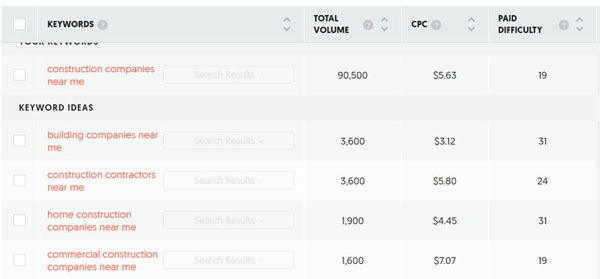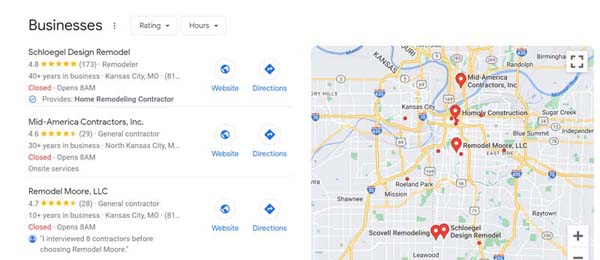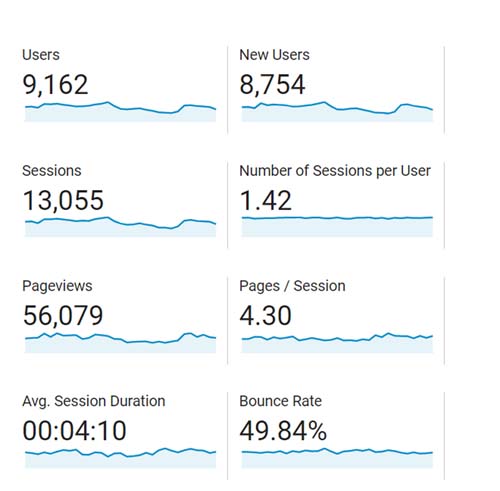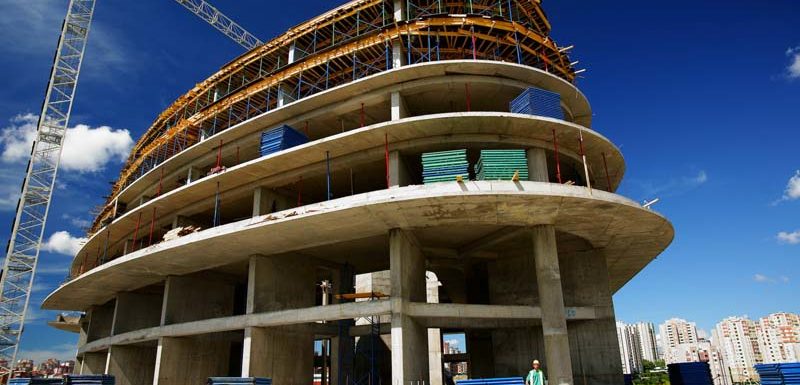SEO for construction companies is important because the majority of them are local businesses. If your website and overall digital presence are optimized for local searches, you will get organic leads without spending a penny on paid advertising. Just take a look at the search volume for the keyword ‘construction companies near me ’. This keyword is searched nearly 100,000 times a month on Google.

In this guide, we are going to discuss how to do SEO for construction businesses and contractors:
Table of Contents
Step#1: Improve local SEO
As I mentioned before, construction is a local business. As a contractor, you will most likely want to target people in a specific geographic area such as a city or community.
For example, let’s say you are a Kansas City-based contractor. You will want people in Kansas City to be able to find you when they perform a search in Google such as a contractor near me or a contractor in Kansas City.
You must have seen GMB listings ranking for such terms.

You can optimize the listing of your business or a webpage on your website for these types of searches.
There are certain steps you can take to achieve this. Here are a few of these steps:
- You should not only have a GMB listing for your contractor business but also keep updating it with the latest articles and information from time to time. GMB is not just a listing platform, but also a great tool to promote your business with content marketing. In order to optimize your GMB listing, make sure that you fill out all the information including website URL, phone number, business description, service areas, menu information, etc. Also, make sure that these details are correct and updated. Select the right category for your business.
- List your website on local business listing directories including Yelp. I have already mentioned that the NAP should be consistent throughout these listings.
- Get reviews from your past clients. Reviews must be genuine.
- If you are organizing events as a construction company, make sure that you list these events in your GMB listing and other event listing websites.
- Utilize schema markup for local businesses. Schema markup is a language that search engines use to understand the relevance and read the content on your website. For example, if you have just updated an event, you should use event schema to help Google understand the changes made to the schedule or venue. It’s a bit technical, so you should hire an SEO professional to do this for you.
- The content you publish should address the people living in your target geographical area. For example, if as a Kansas City-based contractor, you are writing a blog post on construct cost estimation, put the name of the city in the headline and a few times throughout the content. Also, make sure that you actually provide the construction cost details for Kansas City, not New York.
- Have applications that allow customers to message businesses online. The GMB app is a good example. It will allow you to reply to messages immediately. This will improve the ranking of your business listing as this will make it more interactive. If you are not available to answer all the time, use the automated message services offered by these apps including Facebook Messenger, Instagram, and GMB.
- Use Google tools such as Google Question Hub and Google Trends to understand what people in your area search for related to your construction business. Google Question Hub is a tool that shares questions that have not been answered and Google wants publishers to create authentic content around these questions. Google Trends helps you find local topics that are trending in search.
- More and more people are using voice search to find local businesses. Find out the questions about the construction business or services that are most frequently asked by your potential customers. Create easy-to-consume content in form of answers to these questions. This will optimize the content for voice searches. You can use Google’s People Also Ask tool. In order to optimize your website for voice searches, make sure that your website is responsive and mobile-friendly.
- Create a hyper-local marketing strategy by creating content for smaller communities within your target area. So for example, if you are a Houston-based contractor, you can create dedicated pages for Katy, Spring, Sugar Land, Kingwood, etc.
- Build backlinks from the websites of other local businesses.
- Include testimonials from local customers to build trust and authority.
- Create viral social media content for your target area audience to build social proof.
Step#2: Improve User Experience
If you want to improve the ranking of your contractor website, nothing is more important than user experience.
Most people think that SEO and user experience are two different things, but the reality is that they are now deeply connected.
If your website offers visitors a great experience and valuable content, they will more likely stay longer and interact with your content. It gives Google a signal that your content is useful and relevant to the users and it will start ranking your content higher.
To measure user experience, you should use Google Analytics. The tool will provide you with useful insights such as:
- How long people are staying on your website (average session duration)
- How many pages they are browning after landing on your website (average pages per session)
- How long people are staying on a specific page on your site (average time on page)
- Exit and landing pages
- How many people are returning to your site?
- How many people leave your site after browsing only one page (bounce rate)
- What channels you are getting traffic from (organic, social, direct, etc)
- Top search queries
- Top landing pages
- Lead funnel efficiency

In order to improve user experience, you need to make sure that your website is not cluttered and is easy to navigate. It loads fast. It contains original content and images. I have discussed some other things you can do to improve user experience in the steps below.
Step#3: Perform an SEO audit
If you already have a website, you should first determine if all the pages and blog posts are optimized for search engines. You can do this by performing an SEO audit. We recently published a guide on SEO audit. Make sure to check out what steps you need to take to perform an SEO audit.
For an effective SEO audit, you will need to have an account on Google Search Console and Google Analytics. Google Search Console is basically a Google tool that keeps track of indexing errors. You can also find out how your website is performing in Google search results.
Google Search Console can be used for the following purposes:
- You get a performance report on the presence of your website’s pages and posts in Google search results. This includes how many clicks and impressions your website and its pages are getting, how many visitors are clicking on the links of your website (click-through rate or CTR), and what the average position of the highest-ranking pages is. You can break down this data for individual pages and posts also. If your website is getting fewer clicks and impressions and the average position is lower over a specific period of time, it means you need to work on improving your site’s presence in Google.
- Google Search Console also tells you how many pages of your website are currently indexed. It means Google has indexed these pages. You can find out if any pages of your website are blocked from appearing in search results. You will get an error report on this.
- Sitemaps are an important part of technical SEO. Sitemaps are basically a file that Google uses to see indexable pages, posts, tags, categories, videos, etc. In this section of the Google Search Console, you will find if Google encountered any errors while parsing the sitemaps submitted by you. You can also other information such as new sitemaps submitted by you, the list of URLs that each sitemap contains, and when these sitemaps were last crawled by Google.
- Google Search Console also allows you to inspect individual URLs – whether they are indexed or not and if not, what is causing Google to ignore them. You can use the URL inspection tool to fix these errors and resubmit affected URLs for indexing.
- The Manual Action Report in Google Search Console allows you to find out if Google has imposed a manual penalty for violation of any Google policies.
- Some other useful information that you can get in Google Search Console includes the Core Web Vital report (insights on the loading speed of your construction business website) and the Mobile Usability Report (how friendly your website is for mobile devices).
Step#4: Keyword research based on your target audience
This is one of the important steps to improve SEO for construction companies or any other business for that matter.
Keywords are phrases that people use when searching for information online. These are called search terms.
Targeting the right keywords is extremely important because if you don’t target the right keywords, your content will not rank high in search results when people use search terms relevant to your business to find information about the construction and building services in your area.
There are plenty of tools to do keyword research. One of them is Google Keyword planner. The tool is primarily used for keyword research for Google Ads PPC, but you can also use this tool for SEO keyword research.
The three most crucial things you need to keep in mind when doing keyword research are:
- For determining the right keywords, you need to understand your target market. For example, if you specialize in commercial construction, you probably shouldn’t target keywords related to residential construction. It means the keywords should be relevant to your niche or target market.
- When you write content targeting a specific keyword, you should keep the intent of the user in mind. For example, let’s say someone is looking for information about ‘building structure for earthquake resistance’. You need to write content that provides useful information about this topic. If you try to rank a page that prompts your construction business for this search term, you can forget about ranking for this keyword. The intent of the user is to find information, not to search for a contractor.
- If your website is new and yet to build authority in Google, you shouldn’t probably go after very competitive keywords. The focus of your keyword research should be to find keywords that have a good traffic volume yet low competition. Long-tail keywords containing 3 or more words such as ‘home remodeling best practices’ will be easier to rank. Did you know hundreds of people perform searches such as ‘Why contractors are so unreliable’ or ‘Why don’t contractors show up’?
Step#5: Write actionable, quality content
Now that you have your list of keywords, you need to write content targeting them. Group together keywords with similar intent and meaning to create a topic. For example: how to hire a contractor and how to vet a contractor have the same intent. So depending on the traffic, you should choose a main keyword and include it in the headlines and subheadings and use the secondary keyword a few times in the content. It will help you avoid keyword cannibalization.
However, content is not only about keyword targeting. You are absolutely wrong If you think you can rank on top of Google just by publishing content on your website.
The content must be high quality and actionable.
Actionable content helps the users achieve their goals by guiding them step-by-step. It provides high-quality content with no fluff. While long-form content ranks high in search engines, you should not write long articles just for the sake of it. Each and every paragraph should offer the users some value. It should be to the point and solve a specific problem that the users are facing.
Here are some best practices to follow to make content actionable:
- Include call-to-action (CTA): In order to make the content interactive, the content must have a CTA. This will not only make the content interactive and engaging but also help you generate leads. You can use video testimonials, calculators (construction cost calculator), quizzes, and infographics to make the content engaging. However, make sure that you don’t use multiple CTAs on a single page. It will confuse the users. You should determine your CTA by taking into consideration the intent of the user. The CTA should help the user determine the next steps they can take on your website.
- In order to make the content trustworthy, you can refer to studies, quotes, and data from credible sources. For example, if you are publishing an article on construction costs in your local area, you can refer to studies conducted by an association of contractors and use the quotes and data from this study. Make sure to link back to the source material.
- Make your content easy to skim with images, infographics, and data tables. They will make consuming content easier and provide a great user experience.
- Provide real-life examples from other projects. So if you are publishing content on construction costs, you can cite some examples from your past projects.
Step#6: Improve on-page and technical SEO
On-page SEO is something that helps Google and other search engines understand your content. On-page SEO helps optimize various components of your websites. You can improve on-page SEO by writing high-quality content that we have talked about already, improving the HTML and URL structure of your website, and making its navigation and architecture more user-friendly.
Here are some best on-page SEO practices for construction companies and contractors:
- In order to improve the title and headlines of the web pages, make sure that you use proper HTML elements for them which are ‘title’ and ‘h1’. There should be only one main headline marked with an H1 tag. All subheadings should be marked in H2, H3, and other headline tags. The headline should contain the main keyword that you are targeting.
- Make sure that you use a meta title and meta description for each web page and article.
- Images should be optimized with an Alt tag and optionally have a caption.
- We have already discussed schema markup and structured data. Make sure that you are using organization-level structured data as well as page and page-specific structured data to help Google understand your content.
- The URLs for pages and posts should be short and relevant. For example, if you are publishing a construction cost calculator, the URL can be yourwebsite.com/construction-cost-calculator. Never use pages and signs in your URLs. Each URL should be unique.
- Improve internal linking. It means web pages should be linked to each other. For example, if you are publishing a post on how to remodel a house the right way, you can link this article to other articles that you have published on the same topic in the past. Not only that, you can update the past articles and link them to the new article.
- Make sure that your website is mobile-responsive. It should provide a good user experience on all types of devices including mobile phones and tablets.
- Your construction business website should load fast. Use Google’s Page Speed Insights tool to find out what fixes you need to make to reduce page load time.
- Keep your content updated. For example, if you published a post about construction costs in Florida in 2022, make sure that you update this post in 2023 with new data and then, change the headline to construction cost in 2023.
- Write actionable content. We have already discussed how to make your content actionable and engaging.
Step#7: Content marketing and off-page SEO
In 2023, just writing and publishing content is not enough to rank high in search engine results. You need to market your content so that it reaches your target audience.
Here are a few things you should do after you hit the publish button:
- Share the URL of the content with your email subscribers. If you don’t have an email list, you should start building one right away.
- Find forums where people post questions about construction businesses and services. If you find a question that is relevant to the content you just published, provide a brief answer and mention the content you just published which the forum participants can check out for a more detailed explanation.
- Post the link to the content on all social media platforms including Linkedin, Twitter, Instagram, and Facebook.
- Repurpose the content as video, ebook, and infographics and distribute it on relevant platforms.
These are just some of the most basic content marketing strategies. There are plenty of free articles online to learn how to market your content and what platforms to use. The idea is that you should leave no stone unturned to put the content in front of your target audience.
Step#8: Build backlinks legitimately
Backlinks are the links from other websites to your website. When other websites link to your article, the backlinks will help you rank it higher in search engine results.
While backlinks are still important for SEO for construction companies, you need to make sure that they are from high-authority sites. If a lot of spammy websites link to your article, this will harm your Google ranking rather than improve it.
Some link-building strategies for contractors and construction companies include:
- Create resource pages or studies about the construction sector in your area that high-authority can refer to.
- Interview influencers of the construction sector in your area. Publish the interview on your website and request them to refer to the interview on their social media handles and website.
- Publish guest posts on high-authority websites. Use this strategy carefully because backlinks from websites that mostly have user-generated content might land you in trouble.
- There are some other strategies such as broken-link, link reclamation, local linkbait, and infographic promotion, but you need to be extremely careful while using these strategies. These strategies used to work in the past, but are not so effective in 2023.
Step#9: Consistent online branding of your construction business
If you are a local construction company, you must have created listings on listing websites such as Google My Business (GMB) and Yelp.
Make sure that the name, address, and phone number (NAP) are consistent throughout these listing websites. This information should be accurate and updated. If your number has changed, you should update all the listings.
If you haven’t already claimed your listing on GMB and other platforms, you should do it immediately. It will boost local SEO for your construction business which brings us to the next step.
Conclusion
these are just some of the steps that you need to take to improve SEO for your construction business. As a contractor, it’s a good idea to focus on local SEO, so that your target audience can find you.
Keep in mind that user experience is a huge SEO factor in 2023 and beyond. If people are staying for a long time on your website, browsing lots of pages, and interacting with the content, your website will definitely rank higher in search results.
Google wants you to provide the users with a great experience. If you manage to offer it, Google will reward you with better rankings.






